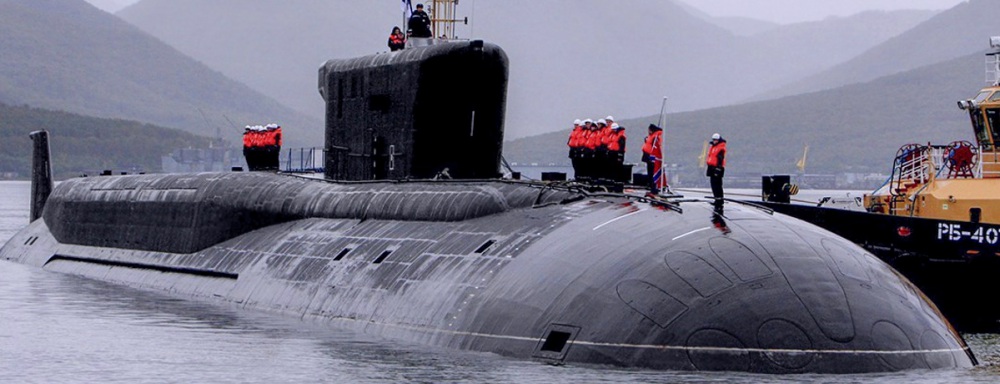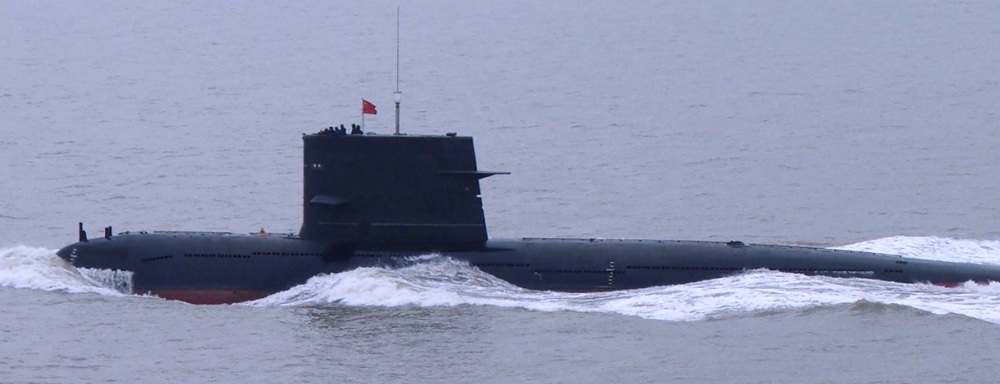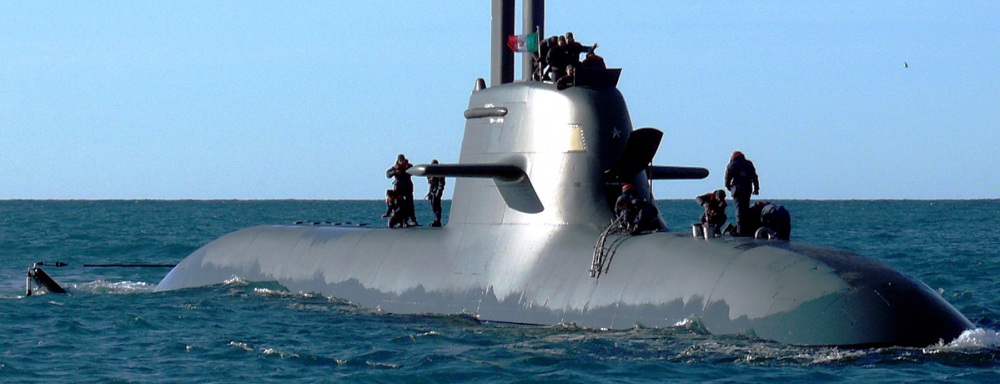Capabilities at a Glance
The United States submarine force consists of four operational classes – Ohio, Los Angeles, Seawolf, and Virginia – all of which are nuclear-powered.1 The 14 Ohio-class SSBNs serve as the sea-based leg of the U.S. strategic triad.2 An additional four Ohio-class submarines are configured as SSGNs that possess both strike and Special Forces insertion capabilities. The three classes of U.S. attack submarines — Virginia, Seawolf and Los Angeles – are tasked with engaging and destroying enemy vessels; supporting on-shore operations and carrier groups; and carrying out surveillance.
Total Submarines in Fleet: 643
- Ballistic Missile Submarines (SSBNs): 14
- Nuclear-Powered attack submarines (SSNs): 50
- Diesel-electric attack submarines (SSKs): 0
- Air-independent propulsion submarines (AIPs): 0
Modernization and Current Capabilities
In its current modernization drive, the U.S. Navy hopes to add two to three Virginia-class attack submarines annually to its fleet until the year 2043. However, achieving the current goal of 48 Virginia-class submarines will likely depend on budgetary accommodations from Congress. The U.S. plans to procure 36 total Virginia-class vessels through FY2026.4 Vice Admiral Michael Connor, former commander of US submarines forces from 2012 to 2015, wrote to the House Armed Services Committee in 2018 that he believes the U.S. needs 66 attack submarines to keep up with the increasing military demand for their underwater capabilities.5
The U.S. Navy is phasing out Ohio-class SSBNs in favor of the newly designed Columbia-class. In June 2018, a Congressional report noted that 12 Columbia-class submarines will replace the 14 Ohio-class vessels currently in service as the new underwater component of the U.S. nuclear triad.6 The first Ohio-class submarine is expected to retire in 2027.7
Each nuclear-powered Columbia-class submarine will carry up to 16 Trident II D-5 submarine-launched ballistic missiles (SLBMs). The same Congressional report noted that, based on the projected procurement schedule, the first Columbia-class submarine will be delivered by in October 2027 and become operational by 2031, at a total cost of $8.6 billion (excluding testing costs). The second submarine in the class will be delivered for testing in October 2030, with the following ten entering the fleet at a rate of one per year from 2032 to 2042, at a total remaining procurement cost of $112.7 billion.8 The Columbia-class submarines will be equipped with an electric-drive propulsion system rather than mechanical, increasing stealth and resilience.9
Ship Biographies
Ohio-class
14 Ohio-class SSBNs form the sea-based leg of the U.S. strategic deterrent triad. The vessels carry Trident II D5 SLBMs, though since 2017, the Navy has been replacing these with Trident II D5LE, a life-extended version equipped with a new guidance system for improved accuracy. Ohio-class submarines previously contained 24 launch tubes each, but the number was reduced to 20 to meet limits under New START.
Assuming an average of twelve operational submarines with 20 launch tubes each and four warheads per missile, these boats carry roughly 960 warheads. However, given that normally only eight to ten of the Ohio-class submarines are deployed at one time due to regular minor repairs, the actual number of warheads in the field is closer to 720.10
Los Angeles-class
The nuclear-powered Los Angeles-class SSN carries Tomahawk land-attack cruise missiles (LACMs) and MK-48 torpedoes. The boat was primarily developed for anti-submarine warfare, but is also capable of inserting Special Forces and laying mines. The Los Angeles-class is considered the backbone of the US submarine fleet with 34 now in commission.11 As a result of technical improvements over time, there are three variants of the Los Angeles-class. Beginning with the USS Providence in 1977, the vessels were equipped with 12 vertical launch tubes for Tomahawk missiles to complement the original Los Angeles-class’s four torpedo tubes. The USS San Juan, commissioned in 1988, was the first of the “improved” quieter Los Angeles-class submarines, fitted with an advanced BSY-1 sonar system, and capable of operating under ice.12 27 of the Los Angeles-class submarines will be retired by the mid-2030s, and five will be refueled to extend their lifespan.13
Seawolf-class
The U.S. Navy also possesses three Seawolf-class vessels, based at Bangor Trident Base in Washington state. Originally developed to hunt Soviet SSBNs, this class of attack submarine runs significantly faster and quieter than the Los Angeles-class.14 The boat’s stealthy capabilities also make it well suited for the insertion of Special Forces. Although it does not possess a vertical launch capability, it can fire Tomahawk missiles through its torpedo tubes.15 While the original plan was to produce as many as 29 submarines, construction costs proved too high and the end of the Cold War meant that their primary function was no longer applicable. As a result, Congress decided to terminate the program at three boats in 1995.16
Virginia-class
The Virginia-class, designed by the Electric Boat Corporation of Connecticut, represents the next generation of U.S. nuclear attack submarines and a more cost-effective alternative to the Seawolf-class. With 15 vessels already in service, the Virginia-class will take over the Los Angeles-class’s operation role. The Virginia-class’s ability to operate effectively in littoral waters, primarily due to its “fly-by-wire” control system, gives it an advantage over the Los Angeles-class, while its unmanned undersea vehicles (UUV) and special force delivery vehicles make it suitable for intelligence gathering and special operation forces missions.17 Furthermore, unlike the Seawolf-class, the Virginia-class possesses vertical launch tubes for firing its land-attack Tomahawk missiles.18 Virginia-class submarines are currently being built at an approximate rate of one per year, but their introduction rate will likely depend in part on the retirement rates of the older Los Angeles-class vessels.19 Most Virginia-class submarines procured in FY2019 and thereafter will be built with the Virginia Payload Module (VPM), a mid-body section equipped with vertical launch tubes.20
Import and Export Behavior
Imports
The United States does not import submarines.
Exports
The United States does not export nuclear-powered submarines and no longer operates, produces, or exports diesel-powered submarines. The U.S. Navy has long opposed the export of diesel-electric submarines due to concerns about the impact of submarine technology proliferation on the ability of its forces to operate securely in coastal waters around the world.
Between 1945 and 1980, the United States provided roughly 25% of exported diesel-powered submarines globally. With the exception of one sale of two submarines to Egypt in 1992 over objections from the U.S. Navy, the United States has not manufactured or exported any diesel-powered submarines since the Cold War.21 Congress did approved contracts for the sale of diesel-electric submarines to Egypt and Taiwan in 2001, but neither came to fruition.22
On 15 September 2021, the United States, United Kingdom, and Australia announced a trilateral partnership called “AUKUS” to assist Australia in acquiring nuclear-powered submarines, among other topics of security cooperation.23 It has not been announced whether or not the U.S. or U.K. will supply the submarines to Australia.24
Explore the Collection
Australia Submarine Capabilities
Brazil Submarine Capabilities
Chile Submarine Capabilities
China Submarine Capabilities
France Submarine Capabilities
Germany Submarine Capabilities
Greece Submarine Capabilities
India Submarine Capabilities
Indonesia Submarine Capabilities
Iran Submarine Capabilities
Israel Submarine Capabilities
Italy Submarine Capabilities
Japan Submarine Capabilities
Malaysia Submarine Capabilities
Netherlands Submarine Capabilities
North Korea Submarine Capabilities
Pakistan Submarine Capabilities
Russia Submarine Capabilities
Singapore Submarine Capabilities
South Korea Submarine Capabilities
Sweden Submarine Capabilities
Taiwan Submarine Capabilities
Your are currently on
United States Submarine Capabilities
Submarine Detection and Monitoring: Open-Source Tools and Technologies
Stay Informed
Sign up for our newsletter to get the latest on nuclear and biological threats.
More on

Russia Submarine Capabilities
Overview of Russia's submarine capabilities and import-export behavior.

China Submarine Capabilities
A highlight of global trends in the sale and acquisition of diesel- and nuclear-powered submarines by country with capabilities, imports and exports. (CNS)

Italy Submarine Capabilities
Overview of Italy's submarine capabilities and import-export behavior.
Glossary
- SSBN
- Ship, Submersible, Ballistic, Nuclear: A hull classification for a submarine capable of launching a ballistic missile. The "N", or nuclear, refers to the ship's propulsion system. SSBN's are generally reserved for strategic vessels, as most submarine launched ballistic missiles carry nuclear payloads. A non-strategic vessel carries the designation SSN, or attack submarine.
- SSGN
- Ship, Submersible, Guided, Nuclear: A hull classification for a submarine that carries guided cruise missiles. The "N", or nuclear, refers to the ship's propulsion system. Also known as attack submarines, SSGNs serve a conventional military support role and are often used for special forces transportation.
- Submarine-launched ballistic missile (SLBM)
- SLBM: A ballistic missile that is carried on and launched from a submarine.
- Deterrence
- The actions of a state or group of states to dissuade a potential adversary from initiating an attack or conflict through the credible threat of retaliation. To be effective, a deterrence strategy should demonstrate to an adversary that the costs of an attack would outweigh any potential gains. See entries for Extended deterrence and nuclear deterrence.
Sources
- “Fleet Ballistic Missile Submarines — SSBN,” Fact File, United States Navy, 13 June 2018, www.navy.mil; “Attack Submarines — SSN,” Fact File, United States Navy, 13 June 2018, www.navy.mil.
- Hans M. Kristensen, “US Releases Full New START Data,” FAS Strategic Security Blog, 12 December 2011, www.fas.org.
- “Navy Virginia (SSN-774) Class Attack Submarine Procurement: Background and Issues for Congress,” Congressional Research Service, 21 December 2022, www.sgp.fas.org.
- “Navy Virginia (SSN-774) Class Attack Submarine Procurement: Background and Issues for Congress,” Congressional Research Service, 21 December 2022, www.sgp.fas.org.
- Michael J. Connor, U.S. House Armed Services Committee, 12 June 2018, www.house.gov.
- “Navy Columbia (SSBN-826) Class Ballistic Missile Submarine Program: Background and Issues for Congress,” Congressional Research Service, Updated 25 January 2023, https://fas.org.
- Hans M. Kristensen and Matt Korda, “United States nuclear forces, 2023,” Bulletin of the Atomic Scientists, Vol. 79, no. 1, January 2023, www.fas.org.
- “Navy Columbia (SSBN-826) Class Ballistic Missile Submarine Program: Background and Issues for Congress,” Congressional Research Service, updated 25 January 2023, https://fas.org.
- Hans M. Kristensen and Matt Korda, “United States nuclear forces, 2023,” Bulletin of the Atomic Scientists, Vol. 79, no. 1, January 2023, www.fas.org.
- Hans M. Kristensen and Matt Korda, “United States nuclear forces, 2023,” Bulletin of the Atomic Scientists, Vol. 79, no. 1, January 2023, www.fas.org.
- “USS San Juan Arrives at Portsmouth Naval Shipyard,” Seacoastonline.com, 9 April 2010; Lt. Cmdr. Jennifer Cragg, “USS San Juan Changes Commanders,” US Navy Submarine Group 2 Public Affairs, 27 April 2012, www.navy.mil; “SSN-21 Seawolf-class,” Federation of American Scientists, www.fas.org.
- “Attack Submarines — SSN,” United States Navy, 10 November 2011, www.navy.mil.
- Megan Eckstein, “US Navy avoided a 2022 ‘trough’ in submarine fleet size, but industry challenges threaten future growth,” Defense News, 3 January 2022, www.defensenews.com.
- “SSN-21 Seawolf-class,” Federation of American Scientists, www.fas.org.
- “Attack Submarines — SSN,” United States Navy, 10 November 2011, www.navy.mil.
- “SSN-774 Virginia-class NSSN New Attack Submarine,” Federation of American Scientists, www.fas.org.
- “Virginia Class,” Jane’s Fighting Ships, 9 April 2013, www.janes.com.
- U.S. Library of Congress, Congressional Research Service, Navy Ohio Replacement (SSBN[X]) Ballistic Missile Submarine Program: Background and Issues for Congress, Richard O’Rourke, CRS Report R41129 (Washington, D.C., Office of Congressional Information and Publishing, 3 July 2013).
- “Submarine FAQs,” Chief of Naval Operations: Submarine Warfare Division, www.navy.mil.
- “Navy Virginia (SSN-774) Class Attack Submarine Procurement: Background and Issues for Congress,” Congressional Research Service, 21 December 2022, www.sgp.fas.org.
- Danielle Revelle and Lora Lumpe, “Third World Submarines,” Scientific American, August 1994, p. 16-21; Headley, Tyler, “Is It Time for America to Start Selling Diesel Submarines Again?” The National Interest, 21 September 2018, www.nationalinterest.org.
- Vago Muradian, “Litton Team Works Egyptian Diesel Sub Deal with DoD’s Blessing,” Defense Daily International, 20 October 2000, www.lexisnexis.com; Pamela Hess, “Ingalls May Build Submarines for Taiwan,” United Press International, 24 April 2001, www.lexisnexis.com; “Submarine Forces (Egypt),” Jane’s Underwater Warfare Systems, 21 January 2011, https://articles.janes.com; Wade Boese, “Bush Approves Major Arms Deal to Taiwan, Defers to Aegis Sale,” Arms Control Association, May 2001, www.armscontrol.org; Edward Cody, “Politics Puts Hold on Taiwan Arms Purchase,” The Washington Post, 10 October 2004, www.washingtonpost.com; Edward Cody, “Politics Puts Hold on Taiwan Arms Purchase,” The Washington Post, 10 October 2004, www.washingtonpost.com; Michael Ashby and Jeff Abramson, “U.S.-Taiwan Arms Deal Angers China,” Arms Control Today, March 2010.
- “Joint Leaders Statement on AUKUS,” The White House, 15 September 2021, www.whitehouse.gov.
- Noah Mayhew, “AUKUS and nuclear-powered submarines: Let’s all just take a breath,” Bulletin of the Atomic Scientists, 17 November 2022, www.thebulletin.org.
